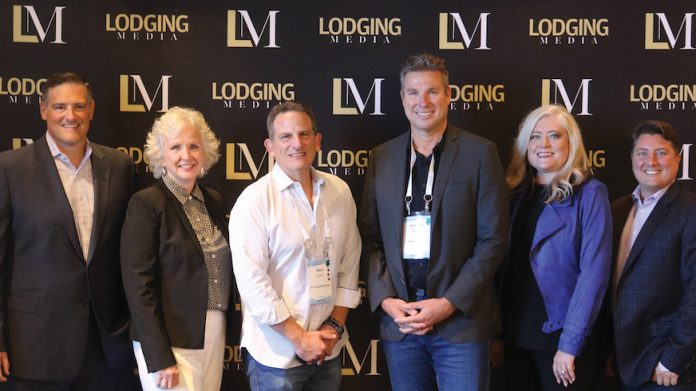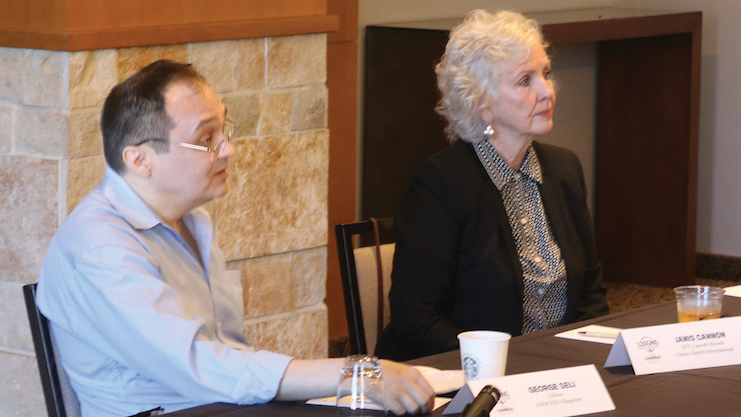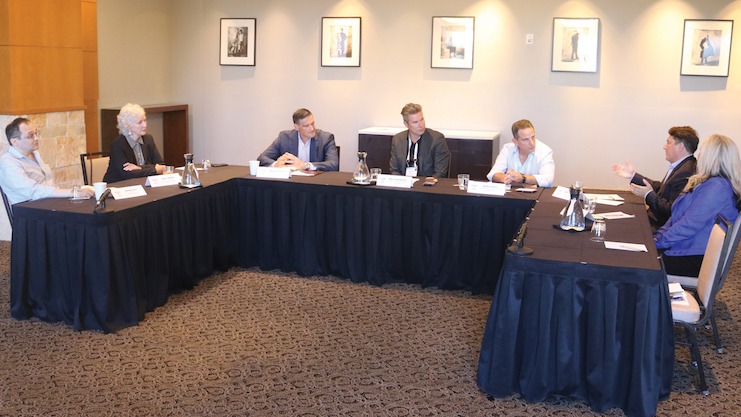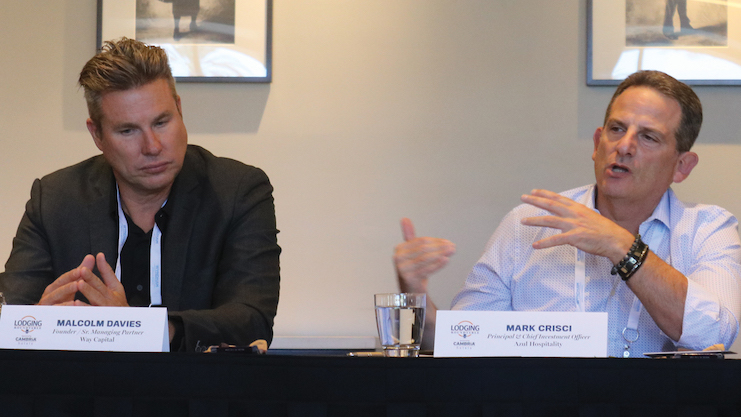
This year’s Lodging Conference created a dynamic setting for attendees to share ideas via presentations, panels, interviews, and plenty of informal gatherings. LODGING was pleased to partner with Choice Hotels International to stage a roundtable for four experts in finance, development, management, design, and other areas of the hospitality industry. Participants included Mark Crisci, principal & chief investment officer, Azul Hospitality; Malcolm Davies, founder & senior managing partner, Way Capital; Rachel Nyman, managing member – regional manager, Lincoln Asset Management; and Harry Wheeler, principal, Group One Architecture.
Moderators
George A. Seli, Managing Editor, LODGING; Janis Cannon, Senior Vice President, Upscale Brands, Choice Hotels; Mark Shalala, Senior Vice President, Upscale Development, Choice Hotels
Panelists
Mark Crisci, Prinicipal & Chief Investment Officer, Azul Hospitality; Malcolm Davies, Founder & Senior Managing Partner, Way Capital; Harry Wheeler, Principal, Group One Architecture; Rachel Nyman, Managing Member – Regional Manager, Lincoln Asset Management
Moderated by LODGING Managing Editor George A. Seli and hosted by Choice Hotels’ Janis Cannon, SVP Upscale Brands, and Mark Shalala, SVP Upscale Development, the discussion was rich with insights on the trends, best practices, opportunities, and challenges in the post-COVID hotel industry. Following is a recap of some of the key takeaways.
Investment and Financing Climate
Underwriting land and vertical development costs is currently one of the major challenges to hotel development. “The reality is that we’ve seen a significant escalation in costs with the hyperinflation that’s going on around the country,” Davies observed. Thus, the question becomes, “Is there a big enough spread between the yield on cost and cap rate to make [the project] feasible in today’s environment?” Essential to maximizing yield, Davies said, is a site that is “within really well-located drivers from business group travel and transient leisure.”

Obtaining financing is also facilitated by showing banks and lenders a track record of good performance, especially within the market in question. “We are growing our current assets [and] we’re able to show that this market is doing well. So as long as you have that reputation and you’ve invested in your own properties, it’s not really that horrible of a challenge to get capital,” Nyman maintained.
And while costs have been rising, “investment sale activity has actually been quite positive,” Davies added. There has been a focus on “forward projections and valuing the assets that way, and we see that as a benefit.” Overall, “you’re seeing massive growth of capital flowing from other types of investments into commercial real estate,” he noted.
Construction Trends
Davies observed a move away from allowances on the construction project GMP (guaranteed maximum price). “We have to have a real GMP that we can really believe in. At the moment that we put the shovel in the ground, it used to be that there were allowances in the GMPs. And that’s kind of going away, which means that we have to work much more closely with our contractors to actually make sure that we can deliver all the cool things we’re adding into the hotels,” he explained. Wheeler also attested to a more stringent approval process: “Projects would normally start and you could get your financing locked in on the GMP with allowances at a design development level. Now it’s ‘Nope, get the permit, I want to know the project is going to happen. … Bid out to five people, show me the data, and then we’ll make a decision.’ So it’s taking an extra six to nine months to get across the finish line.” As a result, expectations as to the timeline of the process need to be adjusted.
“Everybody’s trying to work more closely aligned with each other,” Davies concluded. “The good news is we’ve got a great customer coming in, spending a lot of money on our assets. So, let’s solve the problems” involved in completing the project.
Value Engineering
Although the concept of value engineering has become more prominent in a time of rising construction costs, Wheeler feels the approach is more of a last resort than a best practice. “It’s kind of our motto in our office that if we get to a point where we have to value engineer, we haven’t done our job right with our client,” he said. “We have set our schedules and our delivery methods in our review periods with budget check-ins and budget exercises. So, if it’s a $50 million project, we know at every phase, if it’s going to be $49 million or if it’s going to be $52 million. We have that conversation. And before we have to value engineer, we can make smarter decisions.” Collaboration is thus critical to avoiding recourse to less expensive design elements that may not align with brand standards. “It’s very important that early on in the project, ownership, management, and the designer be on the same page,” Crisci added.
Secondary Markets
The well-known real estate mantra concerning “location” is more relevant than ever in hotel development. As Davies explained, a promising location helps to draw financiers. And what makes a location promising is that it meets current traveler preferences, such as walkability to restaurants, bars, shopping, and other local sites of interest. “With today’s guests looking for more of an experiential stay, they want to have some of those local amenities surrounding them,” Shalala said. “So, the closer we can locate our hotel [to those sites], the more success we’ll have.”
Properties in drive-to destinations have shown particular appeal for developers and financiers. “The financing market for [hotels in] drive-to destinations is much bigger than it has been in the past,” Davies noted. For Wheeler, hotel projects in secondary markets are a big focus right now. “We’re spending a lot on those types of development projects—50-, 60-, 70-room motels that we normally drive by that have excess land for parking. … They’re a great development opportunity,” he says.
 Nyman observed that many developers wouldn’t normally consider secondary markets, but that is changing. “You think about those being lower-power markets, and that’s simply not the case anymore. Because as people have changed their travel behavior … it’s not always going to be ‘I’m going to the city center of the destination,’ [but rather] ‘I want something off the beaten path and I’m willing to pay for that experience.’ We have a lot of issues, as we all know, with airline travel, [and so travelers] want to be able to drive, and they want an experience.” Accordingly, she has found that hotels in secondary and even tertiary markets are demonstrating great RevPAR.
Nyman observed that many developers wouldn’t normally consider secondary markets, but that is changing. “You think about those being lower-power markets, and that’s simply not the case anymore. Because as people have changed their travel behavior … it’s not always going to be ‘I’m going to the city center of the destination,’ [but rather] ‘I want something off the beaten path and I’m willing to pay for that experience.’ We have a lot of issues, as we all know, with airline travel, [and so travelers] want to be able to drive, and they want an experience.” Accordingly, she has found that hotels in secondary and even tertiary markets are demonstrating great RevPAR.
Soft Brands
Secondary markets also present many opportunities for soft branding, Wheeler added, as the cost to develop a former motel is “not even close to a new-build price, and there is developable land attached to it.”
On the topic of soft brands, Wheeler shared his thoughts on the reasons for the popularity of this type of agreement: “The main advantage of soft branding is the flexibility and ability for a project team to develop a true one-of-a-kind experience that is curated for the specific location and provide an authentic experience or a crafted story. The affiliation with the parent company provides that additional support and strength to allow this to happen.”
By way of example, Nyman related, “We fell in love with the Ascend Collection [a Choice Hotels soft brand] because we were able to create our story, we were able to create this identity. We’ve been able to be very creative with architecture and the artwork, reuse of construction materials, and even within our family history. We named one [property] after our CEO’s grandmother, and we have her picture in the lobby.”
The flexibility should also extend to the operation of the soft-branded property. “Operationally, the property must meet the parent company’s expectations and requirements, but have flexibility in how those standards are delivered,” Wheeler explained. “For instance, the level of service and culture that the staff provides must meet the standards, but the uniforms may be adjusted to be in line with the brand strategy.”
Hotel Design and Narrative
Travelers’ preference for indigenous experiences has influenced hoteliers to imbue their properties with more local flair. While doing so used to be a matter of simply adding local art to the lobby and guestrooms, “it’s gone far beyond that—guests are becoming much more sophisticated,” Wheeler observed. “We really immerse ourselves in that market to try to figure out … two or three things that the neighborhood is known for. And [we consider], how can we tie [the property design and amenities] to local communities, local restaurants, local food and beverage?”
The result is that guests feel as if they’ve experienced the destination even if they did not get a chance to really explore the locale, as is often the case with business travelers or meeting attendees.
While a connection to the local culture is important, the obvious should be avoided in terms of design elements. For example, “everybody knows Austin is [about music] so don’t do music. You’ll have live music in the hotel and on the rooftop and so on, but don’t have hanging musical notes; it’s too much,” Cannon advised. Instead, a focus on the hotel’s unique story—including the name choice, the design approach, etc.—is more compelling to today’s guests. Wheeler observes that, increasingly, his team has been asked by owners and developers to provide a narrative on their design choices (e.g., color and material selection) that staff can learn and convey to guests. Indeed, all hotel staff—from the front desk to the valets to housekeepers—can potentially serve as ambassadors of a particular property and know something about its history and design. Telling that story to guests as part of informal conversations makes a memorable impression.
“To be successful in capitalizing, particularly soft brands or new brands, it is incredibly important that you can tell the story,” Davies affirmed. Hoteliers that can do so show an understanding of the uniqueness of the product they’re bringing to market, and invariably have a strong belief in the project. “We really focus on [whether] they believe it and know it’s going to happen. That subjectivity is [part of] why we do deals—because somebody believes it,” he added.
Sustainability
Part of a property’s narrative can certainly be its focus on sustainability, but truly living up to that core value calls for more than just eco-friendly design features. “Sustainability initiatives only work when the operational team is in lock step with the program,” says Wheeler. “It is one thing to say the building was designed with sustainable initiatives, but the ongoing operations are the key to success with water, energy, and resource consumption. Using the right cleaning products and operational efficiencies [is important], and also championing this so the guests know what is going on. Creating the buzz of how the property is working to help the environment is key to success.”
Employee Engagement
In a time when the hospitality industry is undergoing staff attraction and retention challenges, practices that make employees feel appreciated and promote camaraderie are invaluable. On the reward and recognition front, Nyman related that hotel staff within Lincoln Asset Management’s portfolio enjoy events such as disco parties and special meals, which helps to enhance employee engagement.
Participants also stressed the importance of employee mobility as a means of attracting more people to hospitality careers. Crisci noted, “Our industry is one of the few industries where you can get in at an entry level and move up a ladder very, very quickly, to a point where it’s unbelievable what we pay some of our managerial positions.”
He concluded, “There are so many great case studies of young people that have gone through the industry to change their lives, and we should be telling that story.”















